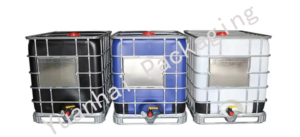Future Market Insights’ latest report forecasts robust growth for the global intermediate bulk container (IBC) market, with sales expected to reach US$ 25.5 billion in 2024. With a projected Compound Annual Growth Rate (CAGR) of 5.5%, the market will achieve a staggering valuation of US$ 43.8 billion by 2034.
Rigid intermediate bulk containers (RIBCs) emerge as highly sought-after products, with demand anticipated to surge at a 5.6% CAGR through 2034. This surge in demand is attributed to the increasing adoption of these industrial packaging solutions across diverse sectors, including chemicals, food & beverages, pharmaceuticals, and lubricants.
Several key factors are driving the growth of the global IBC market:
- Rising Demand for IBCs Due to Increasing Trade Activities: As nations steadily recover from the recent economic downturn caused by the pandemic, trade activity is expected to witness a notable uptick during the forecast period. This surge in trade is poised to drive demand for intermediate bulk containers, with Asia emerging as a key focal point. Additionally, regions like Europe and the Middle East are projected to contribute significantly to global demand due to rising industrial activities and increased trade.
- Booming Paint and Chemical Industries Propel IBC Demand: Industries such as paints and chemicals are experiencing rapid growth, leading to a steady rise in demand for IBCs. These versatile packaging solutions are extensively utilized for storing and transporting paints and chemicals. Stainless steel IBC containers, in particular, are preferred for their resistance to various chemicals, ensuring the safe and efficient transportation of products without compromising quality. The IBC tank market is expected to witness steady growth owing to the essential role of IBCs in the safe transportation of hazardous materials in the paint, coating, and dyes sectors.
Key Takeaways from the Intermediate Bulk Container (IBC) Market
- The global market for intermediate bulk containers (IBCs) is slated to expand at 9% CAGR between 2023 and 2033.
- Total intermediate bulk container (IBC) sales will reach US$ 23.8 billion by 2023.
- In 2033, the global intermediate bulk container (IBC) market is set to reach US$ 46.2 billion.
- Increasing demand for safe and sustainable packaging will drive demand for intermediate bulk containers in the United States.
“As intermediate bulk containers provide numerous benefits over traditional packaging methods, they are gaining immense popularity across the United States,” says a Future Market Insights Analyst.
Competition Landscape in the Intermediate Bulk Container (IBC) Market
Key companies are investing heavily in research and development to innovate new and improved products tailored according to the needs of specific customers. They also use various marketing and promotional strategies to increase awareness of their products and market share.
Recent Developments:
- In December 2022, the recapitalization and merging of two suppliers of intermediate bulk containers (IBCs), Bulk Lift International LLC and Bulk Lift International LLC, was announced by the private equity company New Water Capital (NWC).
- In March 2018, MaschioPack North America sold its manufacturing assets to MAUSER USA, LLC. With this purchase, MAUSER can increase the size of its intermediate bulk container (IBC) business in North America and give manufacturing assistance to its reconditioning subsidiary, National Container Group (NCG).
Competitive Landscape
Companies operating in the intermediate bulk container market are aiming at expansion and strategic partnerships with other manufacturers to expand their product manufacturing capabilities and global presence.
- In 2020, the global packaging and paper group Mondi is investing in its Styria (Austria) plant to boost further its ability to offer safe, clean, and environment-friendly liners for flexible intermediate bulk containers.
- In 2018, Schoeller Allibert’s new foldable intermediate bulk container (IBC), Combo FRUCTUS®, was created to meet the expectations of the tomato paste and fruit juice industries.
- In 2018, Drewsen New technology developed by Austrian manufacturer Starlinger & Co. GmbH (U.S. office is American Starlinger-Sahm, Fountain Inn, S.C.) can produce woven-tape fabric directly from PET bottle flakes. With Starlinger’s “bag bottle” technology, woven bags are made directly from recycled material and can be recycled after use.
- In 2017, Conitex Sonoco USA, Inc., a manufacturer and distributor of flexible intermediate bulk container (FIBC) bags, launched BulkSak on-demand, a web-enabled inventory program that provides new and existing customers on-demand access to over 70 types of ready-to-ship FIBC bags.
Key Segment
By Product:
- RIBC Metal Paperboard Plastic Composite
- FIBC Flexitanks Bags
By Material:
- Metal & Paperboard
- Plastic PE PP PVC
By Content:
- Liquid
- Solid & Semi-Solid
By Capacity:
- RIBC Up to 1,000 Ltr. 1,000 – 1,500 Ltr. Above 1,500 Ltr.
- FIBC Up to 500 Kg 501 to 1,000 Kg 1,001 to 1,500 Kg Above 1,500 Kg
By End Use:
- RIBC Chemicals Petroleum & Lubricants Paints, Inks & Dyes Food & Beverage Cosmetic & Personal Healthcare & Pharmaceuticals Others
- FIBC Chemicals & Fertilizers Food & Agriculture Building & Construction Healthcare & Pharmaceuticals Mining Others
By Region:
- North America
- Latin America
- Europe
- MEA
- East Asia
- South Asia
- Oceania




